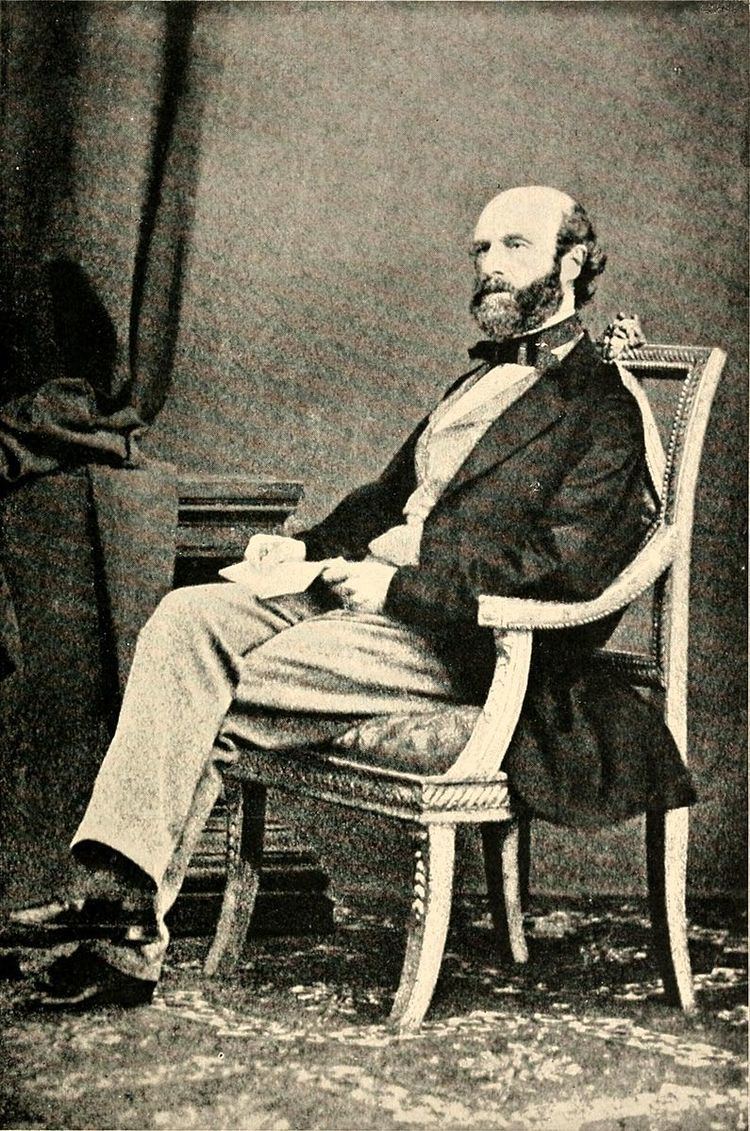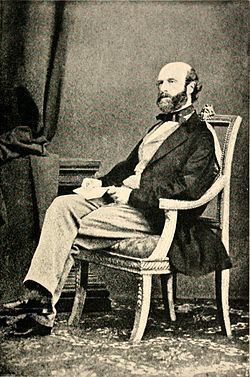Name Alexander Haliday | ||
 | ||
Alexander Henry Haliday (also known as Enrico Alessandro Haliday, Alexis Heinrich Haliday, or simply Halliday (1806–1870)) was an Irish entomologist. He is primarily known for his work on Hymenoptera, Diptera, and Thysanoptera, but worked on all insect orders and on many aspects of entomology.
Contents
- Early life
- Education
- Career
- Later life
- Society memberships
- Technique
- Collection
- Major accomplishments
- Superfamilies
- Hymenoptera
- Other
- Subfamilies
- Unranked taxa
- Notable works
- References

Haliday was born in Holywood, County Down, Ireland. A boyhood friend of Robert Templeton, he divided his time between Ireland and Lucca, where he was a co-founder with Camillo Rondani and Adolfo Targioni Tozzetti of the Italian Entomological Society. He was a member of the Royal Irish Academy, the Belfast Natural History Society, the Microscopical Society of London,, and the Galileiana Academy of Arts and Science, as well as a fellow of the (now Royal) Entomological Society of London.
Alexander Haliday was among the greatest dipterists of the 19th century and one of the most renowned British entomologists. His achievements were in four main fields: description, higher taxonomy, synonymy, and biology. He erected many major taxa including the order Thysanoptera and the families Mymaridae and Ichneumonidae.
Early life
Alexander Henry Haliday was born in Clifden, Holywood, a small seaside town in County Down, Ireland on November 21, 1806. He was the eldest child of Dr William Haliday (1763-1836) and Marion Webster. Haliday had a brother named William Robert and a sister named Hortense. His father was the nephew and heir of Dr Alexander Henry Haliday, one of Belfast’s best known physicians and political activists. The Haliday family was Protestant, though not religious, and clearly well-placed, holding 3,228 acres (13.06 km2) of farmland in County Antrim valued at £3,054.00 in 1820 (£246,763.20 in 2017). The family also owned properties in Holywood and Dublin and had a cloth merchant business and shipping interests. The Haliday family was related to the wealthy Luccan Pisani family, whom Haliday visited often throughout his life.
Education
Haliday began his education at the Belfast Academical Institution, a school that had strong leanings towards natural history. Haliday studied Classics when he was twelve, Arithmetic when he was fourteen, and Mathematics when he was sixteen. He learned several other subjects, including natural history from George Crawford Hyndman. Haliday left the Belfast Academical Institution and the family home in nearby Holywood at fifteen, moving to Dublin where he entered Trinity College in 1822. He graduated in 1827, and was awarded a gold medal in classics. Haliday then went to Paris, where he stayed for almost a year.
Career
From 1825 to 1840, Haliday spent most of his time in Dublin. He returned frequently to Clifden however, and spent much of his time in London and sometimes visited Lucca, where he stayed with the Pisani family. Haliday also spent much of his time collecting insects across England, most often with Francis Walker and John Curtis at the Darent river and Southgate. In 1835, he joined William Thompson on a tour of England and Wales which began in London at the British Museum and the Zoological Gardens and included visits to Matlock, the Lake District (Vale of Newlands), Crummock Water, Llangollen, and Snowdon. From 1841 and 1848, Haliday spent most, if not all, of his time away from Ireland, mainly at the Pisani family home in Lucca. In 1842, he was appointed High Sheriff of Antrim and lived in the townland of Ballyhowne in the parish of Carnmoney.
From 1854 to 1860, after having moved back to Dublin, Haliday was employed as a Invertebrate Zoology lecturer at the University of Dublin. During these years, he also edited parts of the Natural History Review, became a founding member of the Dublin University Geological Society, gave lectures at meetings of the Dublin University Zoological Association (Trinity College), and curated the insect collections at the same University. He also made regular visits to London, usually staying with Henry Tibbats Stainton. These visits often coincided with meetings of the Entomological Society of London.
Later life
In February 1862, Haliday moved to Lucca. Following a trip to Sicily, he moved into Villa Pisani with his cousin, Mme. Pisani, and her family. Expeditions and meetings with entomologists became much more frequent. From 1862 until his death, Haliday traveled across Italy collecting insects, mainly in the North (Emilia-Romagna, Liguria, Lombardy, Piedmont, Aosta Valley, and Tuscany), although he made two trips to Sicily. Various trips to Switzerland, France, and Bavaria followed, and in 1865, with Edward Perceval Wright, he made an entomological expedition to Portugal. In 1868 and 1870, he toured Sicily with Wright. Haliday died in Bagni di Lucca in 1870 and is buried there in the English Cemetery.
Society memberships
Haliday was a member of the Royal Irish Academy, the Microscopical Society of London, the Entomological Society of London, the Linnean Society of London, the Dublin University Zoological Association, the Dublin University Geological Society, the Italian Entomological Society, the Entomological Society of Stettin, and the Galileiana Academy of Arts and Science.
Technique
Haliday worked mainly with very small insects. Study of the tiny parts required dissection, glass slide mounting, and a very high quality microscope. He acquired his equipment from the London microscopist Andrew Pritchard. Whole specimens were mounted on card using gum, the card being transfixed by an entomological pin of German manufacture.
Since the descriptions were necessarily based on more than one specimen are sometimes ambiguous (based on more than one species). Collecting and general methodology followed the instructions given by George Samouelle in The entomologist's useful compendium; or, An introduction to the knowledge of British insects, comprising the best means of obtaining and preserving them, and a description of the apparatus generally used and Abel Ingpen's manual Instructions for collecting, rearing, and preserving British & foreign insects : also for collecting and preserving crustacea and shells. On collecting trips he used a Coddington lens.
Collection
Haliday's collection comprising 78 boxes was presented by Trinity of Ireland College to the Museum of Science and Art (now the National Museum of Ireland) in 1882, twelve years after Haliday's death. The dating of the parts of the collection is confusing but the bulk of it was put together before 1860. Although the collection was damaged, and substantial portions of it have been lost, it remains a very large insect collection. The bulk of the material collected by Haliday himself is in the orders Hymenoptera and Diptera. The undamaged Hymenoptera material is laid out in numbered blocks of systematised taxa, usually disparate groups (representing species) disposed below the appropriate generic name. Most of Haliday’s specimens are from Ireland, however several of them are from England, Scotland, and Italy. In addition to the specialist collections of Hymenoptera and Diptera, there is Haliday’s own general collection (mainly Coleoptera), and a large body of material added to the collection by other entomologists. The largest single source of donations to the collection was Francis Walker, the London entomologist with whom Haliday had a career-long association. The Walker addition was made up mostly of Hymenoptera and Diptera insects, however it contained insects of most other orders, especially Coleoptera and Thysanoptera. Other collectors represented are John Curtis, James Charles Dale, Jean Antoine Dours, Arnold Förster or Foerster, Hermann Loew, Fernandino Maria Piccioli, G.T.Rudd, William Wilson Saunders, JamesFrancis Stephens, and Thomas Vernon Wollaston. The collection also includes a considerable amount of material taken by Charles Darwin on the Beagle Voyage.
